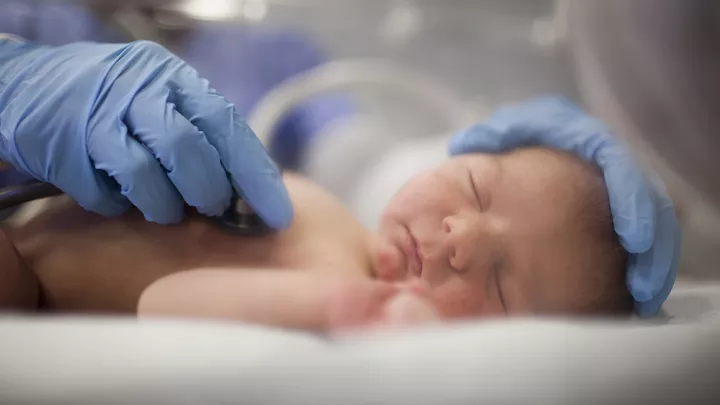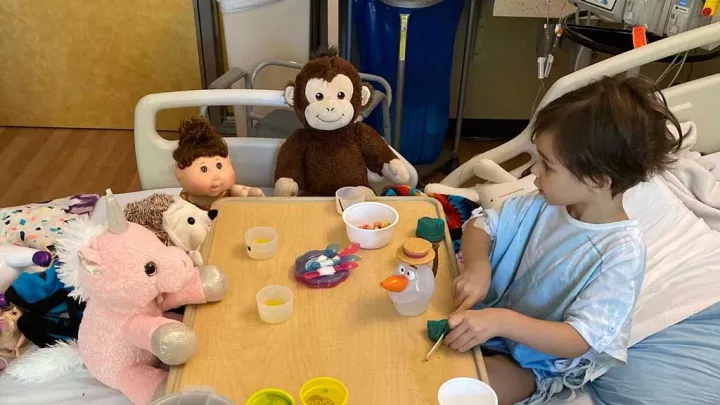Could an Artificial Right Atrium Bridge Fontan Patients to Transplant?

Children’s Hospital Los Angeles recently received a patent for a novel device that aims to solve a vexing problem: how to provide mechanical support for patients with a Fontan circulation.
The device, an artificial right atrium, could potentially offer a way to connect these patients to a ventricular assist device—giving them a much-needed bridge to a heart transplant. Virtually all patients who have had the Fontan procedure will eventually need a new heart, but currently, there are no reliable options for mechanically supporting them while they wait for a transplant.
The idea for the artificial right atrium came from Cynthia Herrington, MD, Surgical Director of the Heart Transplant Program at Children’s Hospital Los Angeles, who has been leading a team of researchers to develop the project. That team includes Heng Wei, MS, and Niema Pahlevan, PhD, of the USC Viterbi School of Engineering; Children’s Hospital Los Angeles Cardiologists Jondavid Menteer, MD, and Sarah Badran, MD; and Vaughn Starnes, MD, Co-Director of the Heart Institute at Children’s Hospital Los Angeles.
Below, Dr. Herrington shares more about the device—and why she felt it was her responsibility to create it.
How would the device work?
The idea is that you would take these patients to the operating room, remove their Fontan and then insert this artificial right atrium and connect it to a ventricular assist device (VAD). It would give us a way of safely connecting them to a VAD, and then they’d have the same chance anyone else would have to recover and go on to transplant.
Where are you in the development process?
We’ve completed the flow dynamic design. When you do the flow design, you’re looking for areas of stagnation. We had to find the optimal design that would be implantable and would fit into the space, but that also would allow blood to move through without having any spots where it could get hung up and clot.
There was a tremendous amount of fluid dynamic analysis that had to go into that. The math was also quite unique because it required careful consideration of non-Newtonian behavior of blood flow. The design minimizes the chance of thrombosis and at the same time preserves the compliance to avoid over-pressurizing the brain and liver.
So we’ve now completed that, and Children’s Hospital Los Angeles received a patent in November. It’s still early in the process. The next phase is to design the device in 3D and start doing animal implants. I’m hopeful we’ll start animal studies later this year.
How is this device different from other attempts to bridge Fontan patients?
Surgeons have tried to do different things—take the Fontan down or cannulate in unusual ways so they can attach a ventricular assist device. Patients can sometimes be supported for short periods of time, but the outcomes have been dismal. The problem is that they don’t really have a right atrium. They don’t have a capacitance vessel.
The artificial right atrium would be something where you could potentially just pull it off the shelf in the size you need, implant it and attach it to a VAD. Then those patients would have the same chance as anybody to recover from heart failure and make it to transplant.
What gave you the idea?
I’ve thought about it for a long time. I’ve been doing sketches for years on the anatomy that I thought would work in the normal Fontan situation, where the device would basically be in the right pericardial space.
I think that for any of the pediatric cardiac surgeons and cardiologists who have taken care of these children, gotten them to the Fontan, followed them their entire lives and watched them grow up into wonderful human beings—it’s really difficult to not have a “what’s next” to get them to transplant safely. So the push was there for us to do something.
What is your hope for the future?
I am hopeful this can be a potential solution and a simple one. We’re going to take it to testing, and my hope is that we can get this to be implantable in a human and to work well. That would be my ideal situation.
But all of us in our community should be thinking about how to best support and take care of these children when the Fontans begin to fail. I think it’s all of our responsibilities.
If I can offer this one piece, and then someone else builds on it and makes it better and we move forward, that’s all I really want. These patients deserve so much more. We need to be able to do this.
In November 2019, Heng Wei, MS, presented the team’s flow design work on the artificial right atrium at the 72nd Annual Meeting of the American Physical Society Division of Fluid Dynamics.


